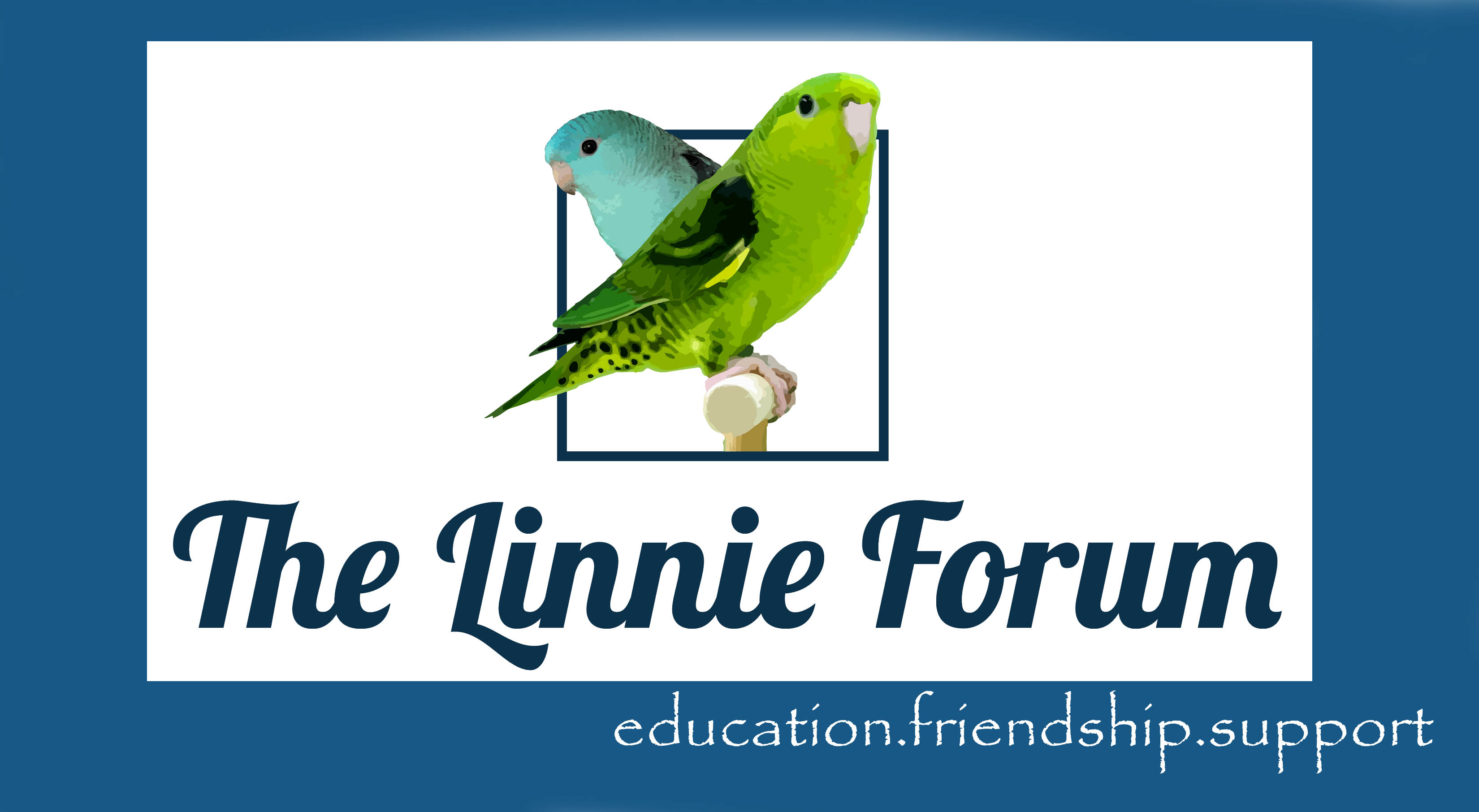Mutation Color ID Guide for Linnies
© Eddie’s Aviary – reproduce only with permission please
One of the exciting things about the Lineolated Parakeet are all the beautiful colors they come in! Identifying the mutations properly is the first step in choosing birds for breeding as some breeders may mistake Greywing mutations, or dark factor greens as they can be the most tricky. This ID article will arm you with the information you need to choose the mutation you find most beautiful to choose for your pet, or to reference if trying to properly identify mutations you want to use for breeding. Remember: a green series bird should be used in each pairing, you cannot pair two inos (red eyes) together, and greywing x greywing is NOT considered an ethical pairing. Remember - photos with a flash can alter the color slightly, as can varying device screens. Ok, lets get to the fun part.... Linnie Pictures!!
Green Series: Dominant
Normal Green aka the "Wild Type" - this color is WITHOUT a mutated gene. This is a no dark factor, dominant trait.
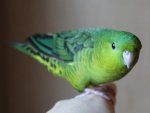
Dark Green (d green) is a single dark factor green series bird. The overall green color is darker, more like Jade green then the Kelly green of the normal. Hens often have a shimmering turquoise colored brow when in condition.
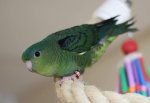
Olive (dd green) is a double dark factor green series bird. The color shift from the brighter, jewel tone greens of the normal and dark green to a hue with more yellow and brown undertones. The color is best described as Army green. One dark factor will be inherited by EVERY chick out of a double dark factor parent. If one parent is double dark, and paired to a no dark factor bird (normal or turquoise) then 100% of young will be a single dark factor (dark green or cobalt). Be sure not to pair two double dark factor birds together, and remember * inos can hide dark factors, you need to know parentage to ensure that your ino isn't hiding the potential of 2 dark factors when pairing to an olive or mauve (dd).
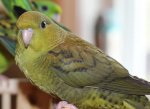
Here is a photo of 3 fledgling baby Linnies. From Left to Right, normal green, dark green, olive (with flash)

Green Series Ino - Lutino. Be sure never to pair two red eyed (ino) birds together for breeding. If using ino in a breeding pair, remember: they can hide dark factors. Ask breeder for parentage to make smart pairings. See our page on Proper Pairing Protocols to learn the pairing guidelines before you start. Ino cannot be visually sexed, but the mutation is sex linked, so sexing that way is often possible. If mom is not a visual ino and you have a red eyed chick in the nestbox, 100% of the time, that baby is a hen.
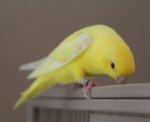
Turquoise Series (par-blue): Recessive
Turquoise - this color is a no dark factor recessive gene mutation.
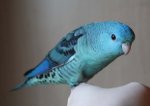
Cobalt (dark factor turquoise) at front, turquoise in back.
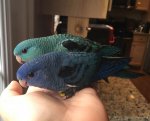
Violet can also ride on any mutation, but in single factor, most easily seen on d turquoise (cobalt) mutations. Depth of color on the head, or in the flights is often mistaken as violet. One of the best ways to determine violet is by looking at the chest. Clean, clear color there, without barring is the best indicator. The cobalt in the photo above is also violet.
Mauve (double dark factor turquoise) -
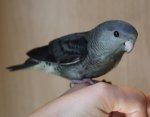
Creamino (turquoise ino) - Be sure never to pair two red eyed (ino) birds together for breeding. If using ino in a breeding pair, remember: they can hide dark factors. Ask breeder for parentage to make smart pairings. See our page on Proper Pairing Protocols to learn the pairing guidelines before you start. Ino cannot be visually sexed, but the mutation is sex linked, so sexing that way is often possible. If mom is not a visual ino and you have a red eyed chick in the nestbox, 100% of the time, that baby is a hen.
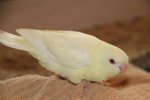
Greywing - the greywing mutation mutes the strength of the black barring, and softens the overall body color in the Linnie. Found in single factor (sf) or double factor (df). Double factor greywing mutations are the result of an unethical pairing, two greywings bred together. There is no need to pair two together even if health problems weren't a concern (they are) because a male sf gw will produce both sf and df looking (very light birds) when paired to a normal barred bird. We don't keep any greywing anymore, but do have a few photos of some we raised back when we did.
We can only post 10 photos to a topic, so we will discuss gw in greater depth in another thread. Below is a photo of a single factor greywing green male. Note the soft green barring vs. the black barring found in a normal barred bird.
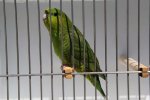
If you enjoy this Forum, or the Content found here helpful.... consider buying the author a coffee. Helps with website costs, and keeps motivation levels up for more late night work. Thank you CLICK HERE to Buy Me A Coffee
CLICK HERE to Buy Me A Coffee 
© Eddie’s Aviary – reproduce only with permission please
One of the exciting things about the Lineolated Parakeet are all the beautiful colors they come in! Identifying the mutations properly is the first step in choosing birds for breeding as some breeders may mistake Greywing mutations, or dark factor greens as they can be the most tricky. This ID article will arm you with the information you need to choose the mutation you find most beautiful to choose for your pet, or to reference if trying to properly identify mutations you want to use for breeding. Remember: a green series bird should be used in each pairing, you cannot pair two inos (red eyes) together, and greywing x greywing is NOT considered an ethical pairing. Remember - photos with a flash can alter the color slightly, as can varying device screens. Ok, lets get to the fun part.... Linnie Pictures!!
Green Series: Dominant
Normal Green aka the "Wild Type" - this color is WITHOUT a mutated gene. This is a no dark factor, dominant trait.

Dark Green (d green) is a single dark factor green series bird. The overall green color is darker, more like Jade green then the Kelly green of the normal. Hens often have a shimmering turquoise colored brow when in condition.

Olive (dd green) is a double dark factor green series bird. The color shift from the brighter, jewel tone greens of the normal and dark green to a hue with more yellow and brown undertones. The color is best described as Army green. One dark factor will be inherited by EVERY chick out of a double dark factor parent. If one parent is double dark, and paired to a no dark factor bird (normal or turquoise) then 100% of young will be a single dark factor (dark green or cobalt). Be sure not to pair two double dark factor birds together, and remember * inos can hide dark factors, you need to know parentage to ensure that your ino isn't hiding the potential of 2 dark factors when pairing to an olive or mauve (dd).

Here is a photo of 3 fledgling baby Linnies. From Left to Right, normal green, dark green, olive (with flash)

Green Series Ino - Lutino. Be sure never to pair two red eyed (ino) birds together for breeding. If using ino in a breeding pair, remember: they can hide dark factors. Ask breeder for parentage to make smart pairings. See our page on Proper Pairing Protocols to learn the pairing guidelines before you start. Ino cannot be visually sexed, but the mutation is sex linked, so sexing that way is often possible. If mom is not a visual ino and you have a red eyed chick in the nestbox, 100% of the time, that baby is a hen.

Turquoise Series (par-blue): Recessive
Turquoise - this color is a no dark factor recessive gene mutation.

Cobalt (dark factor turquoise) at front, turquoise in back.

Violet can also ride on any mutation, but in single factor, most easily seen on d turquoise (cobalt) mutations. Depth of color on the head, or in the flights is often mistaken as violet. One of the best ways to determine violet is by looking at the chest. Clean, clear color there, without barring is the best indicator. The cobalt in the photo above is also violet.
Mauve (double dark factor turquoise) -

Creamino (turquoise ino) - Be sure never to pair two red eyed (ino) birds together for breeding. If using ino in a breeding pair, remember: they can hide dark factors. Ask breeder for parentage to make smart pairings. See our page on Proper Pairing Protocols to learn the pairing guidelines before you start. Ino cannot be visually sexed, but the mutation is sex linked, so sexing that way is often possible. If mom is not a visual ino and you have a red eyed chick in the nestbox, 100% of the time, that baby is a hen.

Greywing - the greywing mutation mutes the strength of the black barring, and softens the overall body color in the Linnie. Found in single factor (sf) or double factor (df). Double factor greywing mutations are the result of an unethical pairing, two greywings bred together. There is no need to pair two together even if health problems weren't a concern (they are) because a male sf gw will produce both sf and df looking (very light birds) when paired to a normal barred bird. We don't keep any greywing anymore, but do have a few photos of some we raised back when we did.
We can only post 10 photos to a topic, so we will discuss gw in greater depth in another thread. Below is a photo of a single factor greywing green male. Note the soft green barring vs. the black barring found in a normal barred bird.

If you enjoy this Forum, or the Content found here helpful.... consider buying the author a coffee. Helps with website costs, and keeps motivation levels up for more late night work. Thank you
